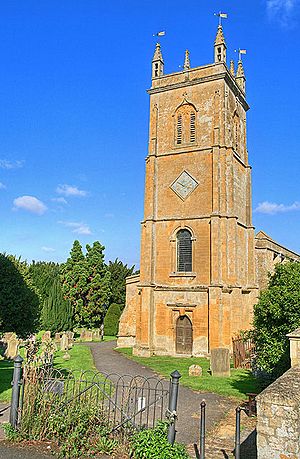Church of St Peter and St Paul, Blockley facts for kids
Quick facts for kids Church of St Peter and St Paul |
|
|---|---|
| The Parish Church of Saint Peter and Saint Paul | |
 |
|
| 52°00′45″N 1°45′42″W / 52.012468°N 1.761557°W | |
| Location | The Square, Blockley, Gloucestershire, GL56 9ES |
| Country | England |
| Denomination | Church of England |
| Previous denomination | Roman Catholic Church |
| Churchmanship | Broad Church |
| History | |
| Status | Active |
| Dedication | Saint Peter Saint Paul |
| Architecture | |
| Functional status | Parish church |
| Heritage designation | Grade II* listed |
| Style | Norman |
| Years built | 1180 |
| Administration | |
| Parish | Blockley with Aston Magna |
| Deanery | North Cotswold |
| Archdeaconry | Cheltenham |
| Diocese | Gloucester |
The Church of St Peter and St Paul is a special church in Blockley, Gloucestershire, England. It belongs to the Church of England. This church is very old and important, so it's listed as a Grade II* listed building. This means it's a historic place that needs to be protected. You might even recognize it from the TV show Father Brown, where it's shown as a different church.
Contents
History of the Church Building
The Church of St Peter and St Paul was built around 1180. It was made in the Norman style, which is an old way of building with thick walls and round arches.
Early Changes and Additions
The main part of the church, called the chancel, has three sections or "bays." Originally, it had six tall, narrow windows called lancet windows. Today, only one of these original windows remains.
In the late 1200s, a two-story part was added to the north side of the chancel. The top floor was a small chapel for prayers, known as a chantry chapel. The bottom floor was a vestry, a room where priests prepare for services.
Around 1310, a new, larger window was put in the east wall of the chancel. Other windows in the south wall were also made bigger in a style called Decorated Gothic.
Later Medieval and Renaissance Updates
By the end of the 1300s, a north aisle was added. This is a side section of the church, connected to the main area (the nave) by a row of arches, called an arcade. In the 1400s, a large Perpendicular Gothic window replaced an older Norman one in the south wall of the chancel.
Changes in the 1600s and 1700s
The south porch, which is an entrance area, was added in 1630. Six years later, in 1636, a clerestorey was built. This is an upper level of the nave with windows to let in more light. The north arcade was likely rebuilt around this time too.
The bell tower was built in 1725, probably replacing an older one. In 1735, a west gallery was put inside the church. This was a raised area, often used for musicians.
Victorian Restoration and Bell Upgrades
In 1871, the church underwent a big "restoration." This means it was repaired and updated. A north porch was also added then.
By 1854, the tower had six bells. The oldest two were made in 1638. The others were from 1679, 1683, 1729, and 1854. Later, the number of bells was increased to eight. In 2016, people started raising money to replace the bell frame and add even more bells, aiming for ten in total.
The Church Today
The Church of St Peter and St Paul is still an active parish church today. It is part of a group of Church of England churches called the Vale and Cotswold Edge team. The vicar for Blockley also looks after nearby villages like Paxford, Draycott, Aston Magna, and the parish of Bourton-on-the-Hill.
Church on Screen
This church is quite famous! It has been used as a filming location for TV shows. An episode of Dalziel and Pascoe called Sins of the Fathers was filmed here.
The church is also used as St Mary's Roman Catholic church in the popular Father Brown television series. In the show, the vicarage next door is even transformed into Father Brown's home.
Recent Bell Work
In 2017, the bell frame was replaced by a company called John Taylor & Co from Loughborough. All the bells were taken down and cleaned. The largest bell, called the tenor bell, was recast (melted down and reshaped). Two new smaller bells, called trebles, were added. All the parts that hold and move the bells were also replaced.
Notable People Connected to the Church
Over the years, several interesting people have been connected to the Church of St Peter and St Paul.
- Erasmus Saunders (1670–1724) was a Welsh priest and writer. He served as a curate and then vicar at the church in the early 1700s.
- Thomas Wilson was a vicar here before he became the Dean of Worcester from 1571 to 1586.
- Thomas Henry Morgan (1898-1957) is buried in the churchyard. He is believed to be the original Welsh composer of the well-known song "We'll Keep a Welcome".
Gallery
External Links
- Church website
- A Church Near You profile






